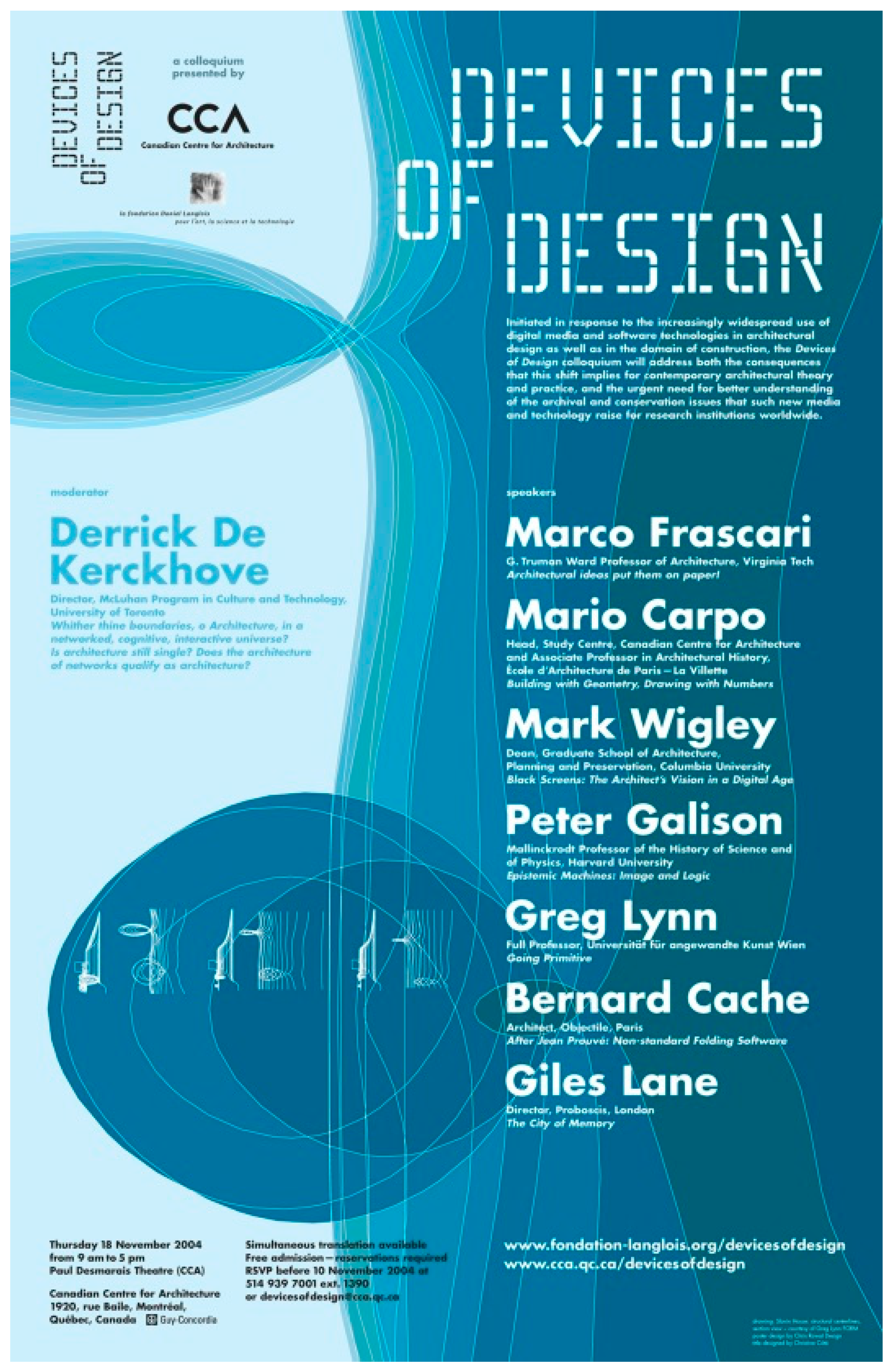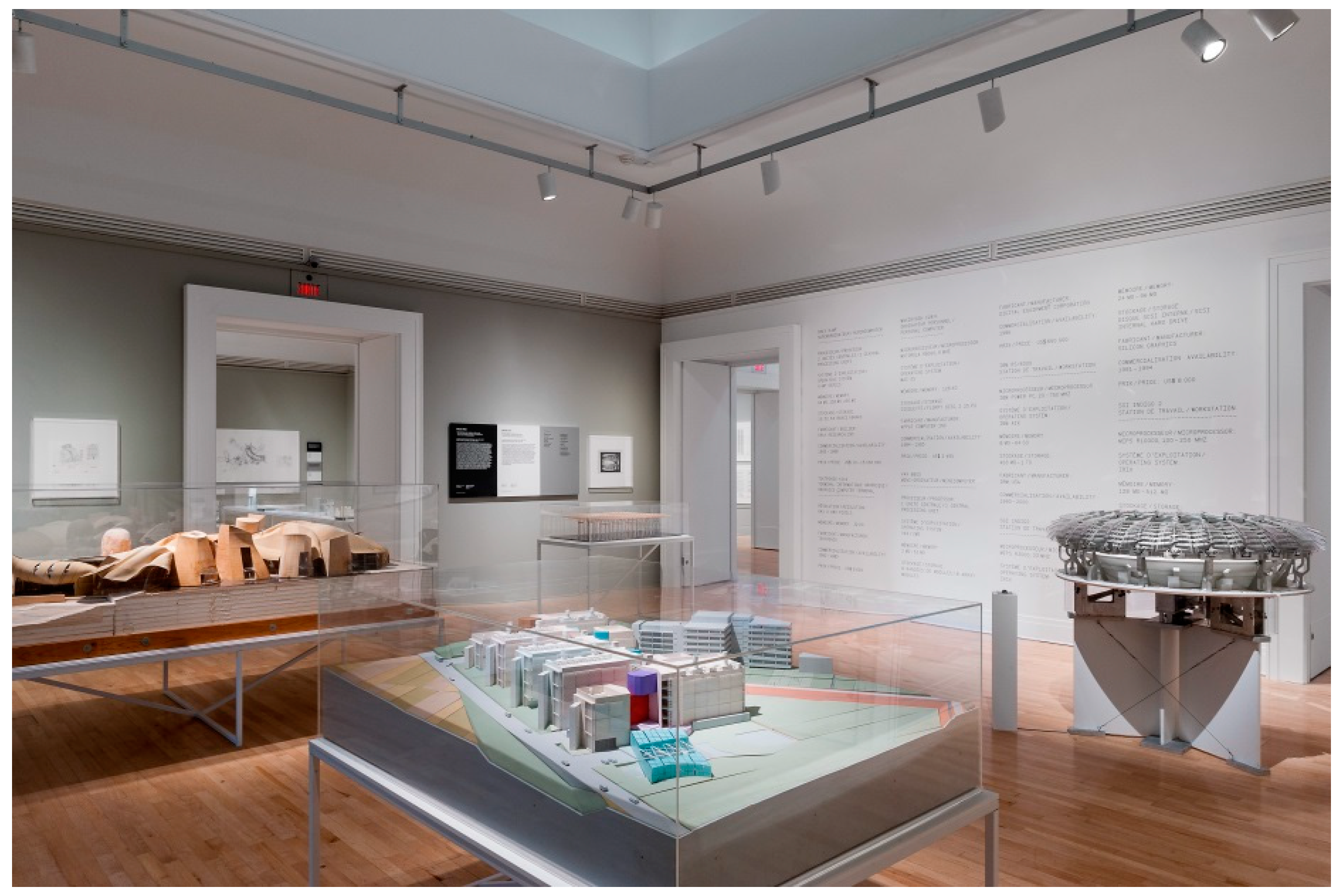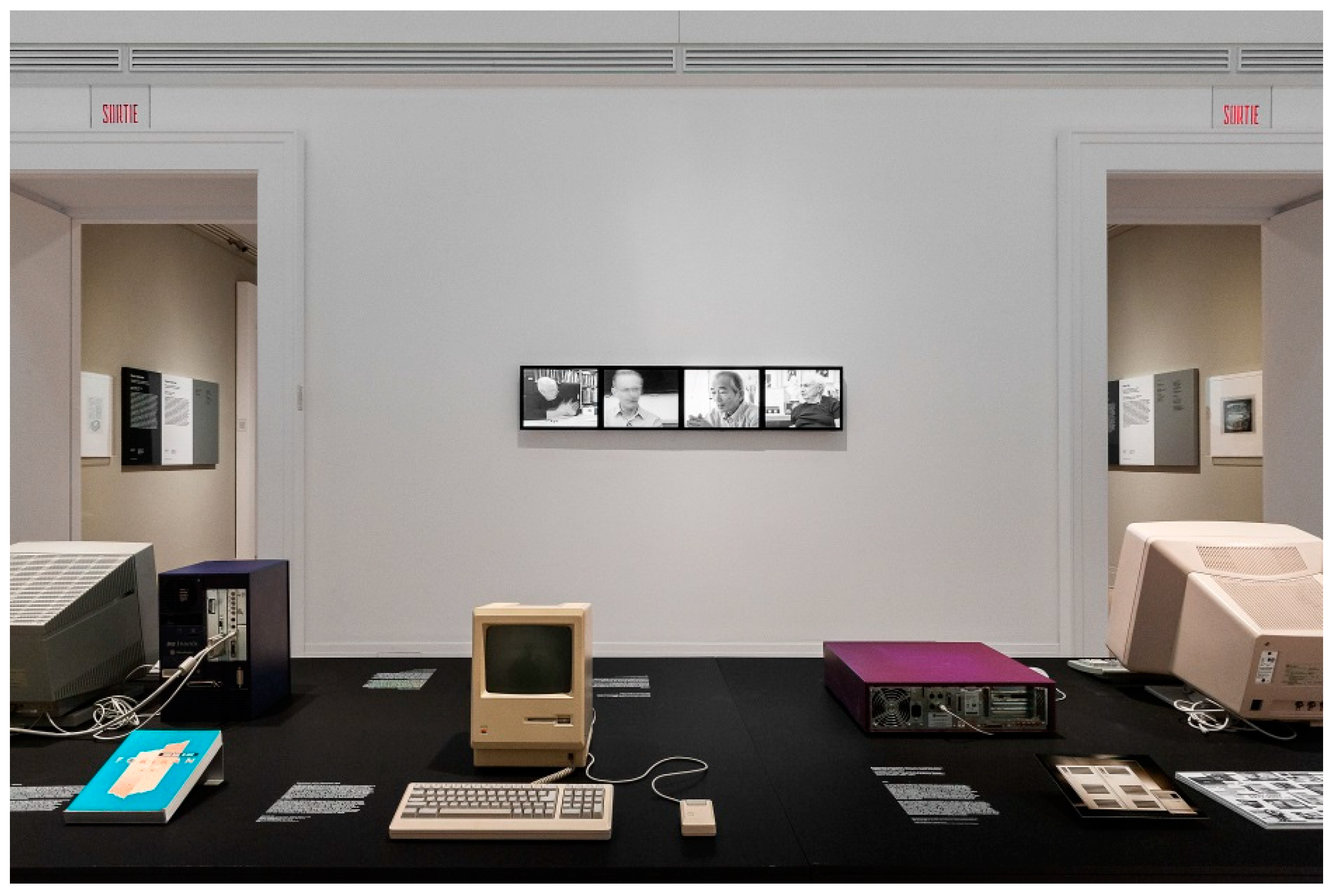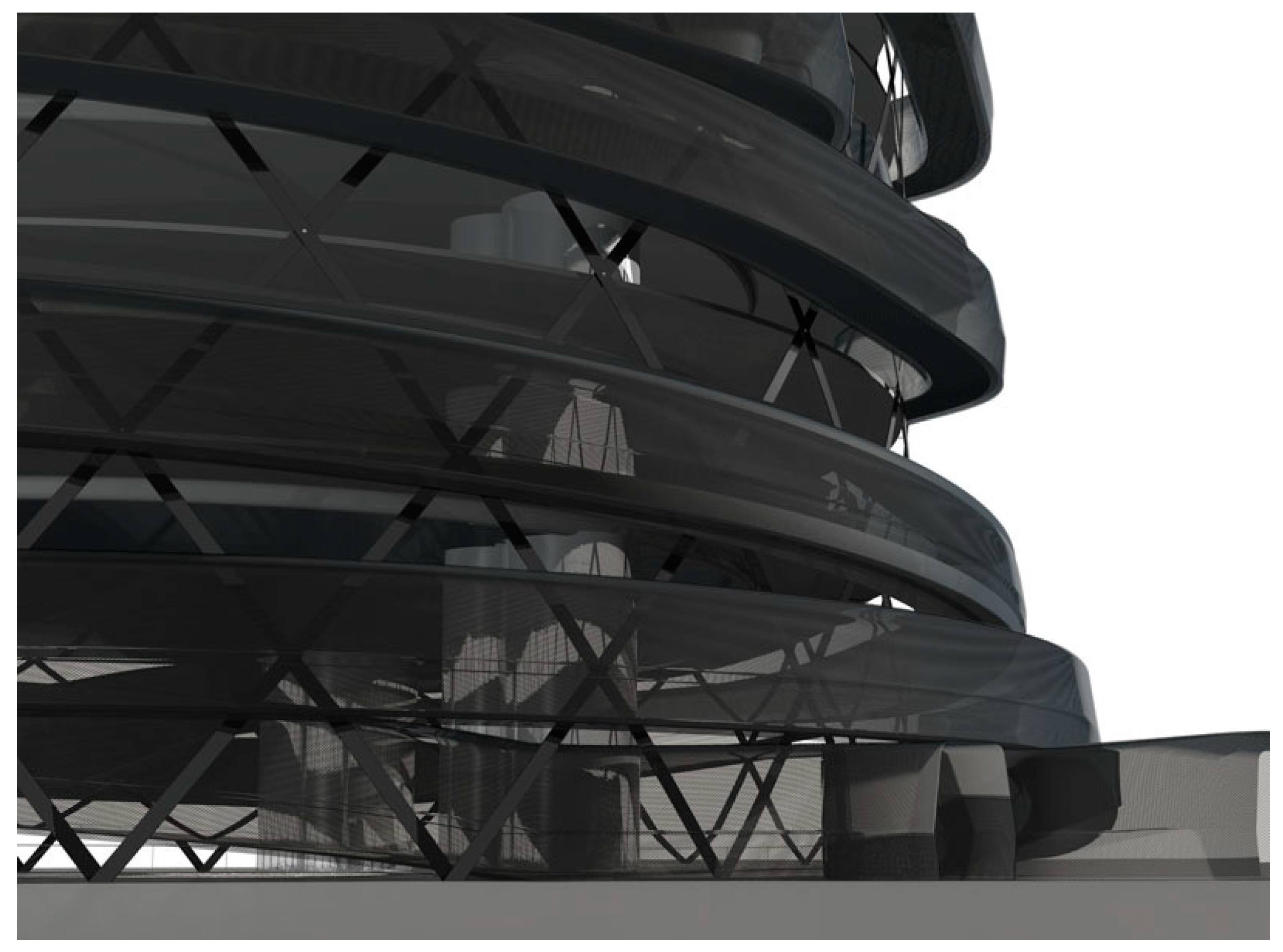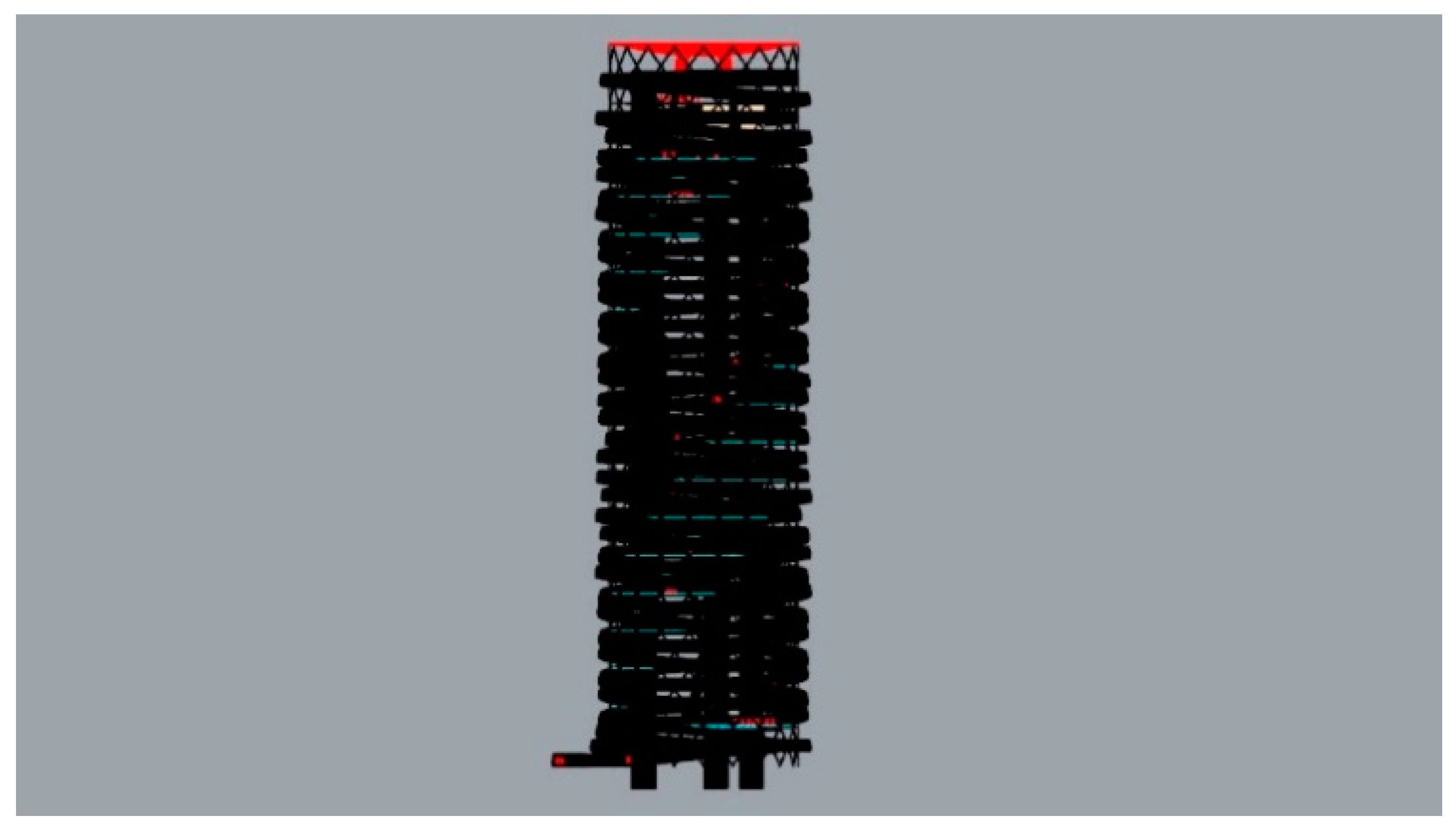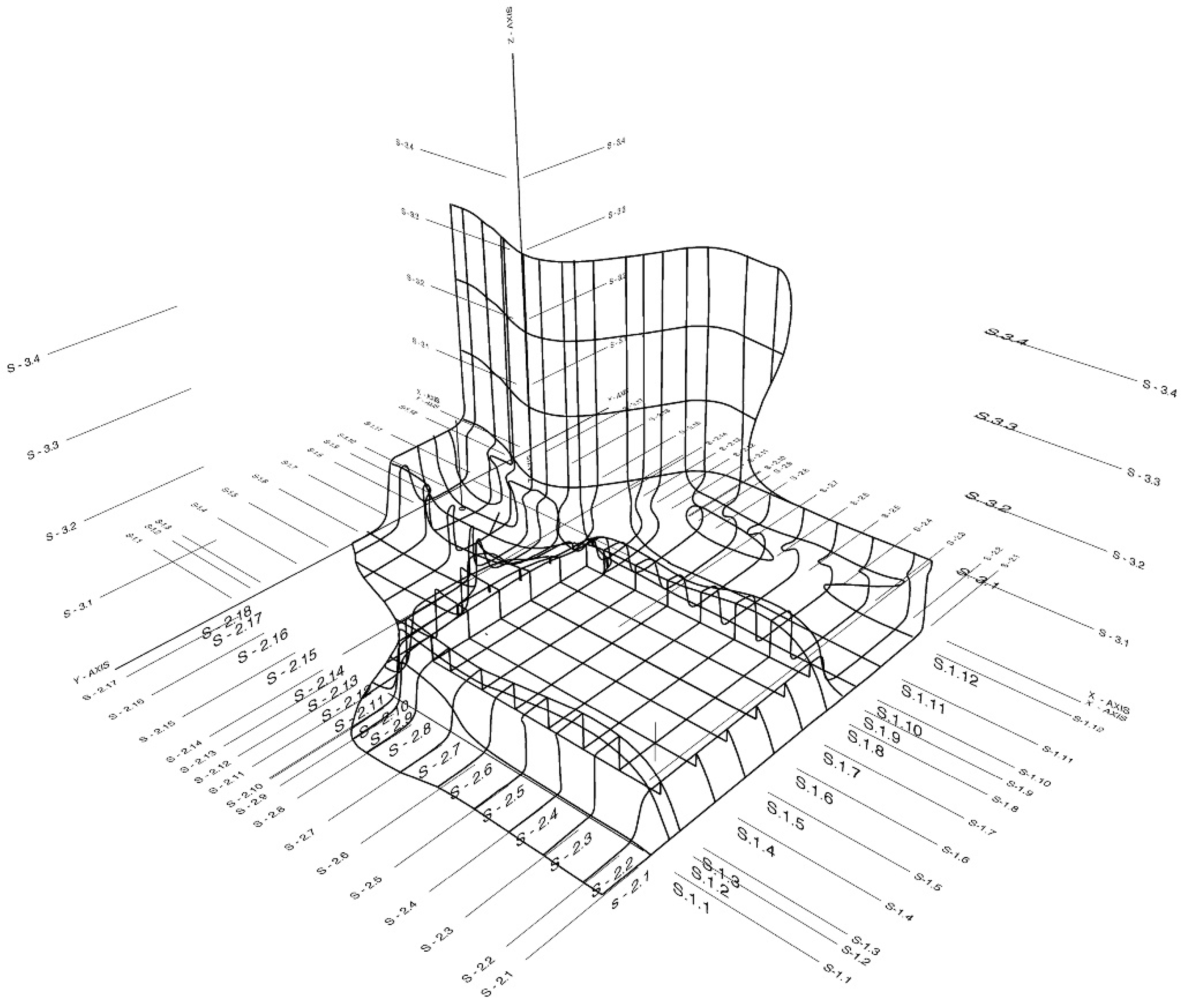1. Introduction
When and how did computational design start to seriously change architecture? (
Zardini 2017)
1. The answer to this question depends on your definition of computational design and, obviously, of changes in architecture. However, something certainly started to change at some point in the 1980s, and we see, interestingly enough, the physical evidence of that in architects’ archives: with the presence of floppy disks and CD-ROMs hidden in boxes of textual documents, photos, or drawings. The Canadian Centre for Architecture (CCA)
2, founded in 1979 and based in Montreal, started to receive this hidden born-digital material, still on physical devices, in the mid-1990s as part of physical archives donated by architects or their estates, although some of the material dates back to 1988
3. This article will address and contextualize the curatorial approach developed at the CCA for collecting, preserving, and giving access to born-digital records.
1.1. Do You Remember Floppy Disks?
At that time, we were not really certain what to do with digital material we received; in fact, we were not even particularly interested in digital material. We would describe the physical appearance of the objects in our finding aid through very general terms, such as “three floppy disks and two tapes”. We did not identify the type of floppy disk or tape and we were not always precise in specifying the quantity of each. The CCA was certainly not alone in this practice: none of the collecting institutions in the field of architecture and urbanism knew how to go about cataloguing born-digital archives or even how to correctly define the problem. For some, it was a question of migration without exactly knowing what the effect of migration was, while others focused on the issue of preservation. But preservation of what, exactly: the device, the medium, the file? At first, some of us (collecting institutions dealing with architectural holdings) imagined that we would have to purchase every single type of computer and related software to open design files or that we would have to migrate files to more recent software versions knowing that we would then lose context, data, and metadata. How would we migrate material for which we did not have the machines or the software, and what about software that was no longer being developed?
1.2. Investigation, Normalization, and Standardization
In this context, it must be noted that the practice of describing physical, architectural archival holdings was also not yet well-developed. As many collecting institutions were established in the 1980s, a more in-depth discussion about archival descriptions for architecture archives only began in the early 1990s. The CCA, for example, received its first archives only after the building opened in 1989; a decade after the institution was founded. Similar institutions opened around the same time, such as the Netherlands Architecture Institute (NAi) that opened in 1991 (as a merger of three different institutions) or the Architekturzentrum Wien (AzW) in 1993. When the International Confederation of Architectural Museums (ICAM) was founded in 1979 (
Snodin 2005), there were many practical discussions among members about how to store drawings, how to describe architecture drawings (is a sketch a drawing, and vice versa?), and how to create a consistent vocabulary for what you see in a drawing (is a “house” the same as a “villa” or a “residence”?). These discussions may seem mundane, but they are crucial for the interpretation of individual architectural drawings and their meaning within an archive or a collection. At the time, in the 1980s and early 1990s, institutions such as the CCA tried to follow and learn from the idea of controlled vocabulary developed by the Library of Congress, but there was no understanding of how to apply this to groups of records, let alone archival aggregates.
It was not until 1994 that the International Council on Archives (ICA) published its first standard, the General International Standard Archival Description (ISAD(G))
4, which the CCA started to implement not long ago (following the more complex RAD (Rules for Archival Description) previously). It took time for many archival institutions to adopt the standard and even more time for museums: the CCA found itself somewhere between the two, with its hybrid collection that includes library holdings, archival holdings, a photography collection, and a print and drawings collection. All this to say that the idea or concept of descriptive standards for physical material is fairly young, and was developed at the same time that architects began using computers.
While standards for archival descriptions were still being refined, and discussed among architectural institutions for describing physical material, in the early 2000s, most institutions realized that they also needed to think about what to do with the born-digital material they were receiving. From 2002 to 2007, the Institut français d’architecture initiated the program Governance, Architecture and Urbanism: a Democratic Interaction (Gau:di) (
Peyceré 2006), which was first joined by the Centre International pour la Ville, l’Architecture et le Paysage (CIVA) in Brussels, Architektur Zentrum Wien (AzW), the Museum of Finnish Architecture in Helsinki, and later by other institutions, such as the Netherlands Architecture Institute (NAi) and the Deutsches Architektur Museum (DAM). It was, and remained, a collective European effort to gain expertise in how architecture practices were operating at that moment; however, they were not able yet to address the preservation of electronic records and bring it into practice. (
Peyceré 2008)
During the same period, in 2003, the Art Institute of Chicago’s Department of Architecture and Design undertook a study to address the requirements for archiving born-digital material. One of its first conclusions was identified while collaborating with architecture practices: “We discovered that digital design tools have become an essential part of the design process and that digital images are central to design decision-making. Many digital images that document key design ideas are never committed to paper, particularly if they are created very early in the design process, or if they are created for a project that is never completed or for an unsuccessful competition entry.” (
Thorne 2005).
Based on the Open Archival Information System (OAIS) functional model, six stages within the born-digital archival lifecycle, from acquisition to access, were identified in the study. Interestingly, preservation is just one of the last stages in the model, while preservation is today considered the first action we rely on after receiving born-digital material. One of the most important notions or conclusions was the introduction of emulation as a solution to be able to view a born-digital file in its original software environment using a virtual machine. At the time, emulation software was primitive, requiring a highly technical overhead and leading many institutions to adopt more low-fidelity solutions, such as migrating proprietary formats to PDF. This was a solution some museums started to work with, while archival institutions, less interested in the individual objects, were unconvinced. The real question here is: What makes an archive? If you need to maintain the integrity and authenticity and convey the relationships between materials and how the architect worked, a PDF is not enough. A collection of PDFs presents the archive as a collection of objects instead of an aggregate of evidence.
One year later, in 2004, the CCA organized the seminar Devices of Design: Architecture and Variable Media in conjunction with the Daniel Langlois Foundation for Art, Science, and Technology, also based in Montreal (see
Figure 1). We realized that we were interested in not just the problem of collecting born-digital material produced by architects, but first of all in the question: What does the use of digital tools mean for architecture? Experts from various disciplines were invited to the symposium. The purpose was twofold: to examine the impact on architectural history and theory and the increasingly widespread use of digital media and software. The discussion was also meant to assess implications for the long-term management and maintenance of digital architecture archives.
Although both the Gau:di initiative and the work of the Art Institute of Chicago were in collaboration with architecture practices, the question as to how digital tools and computers have changed architecture was not answered. The motivation to work with practices was more to understand what architects did and how tools were used, not so much why. Around this time, the FRAC Centre (opened in 1999, based in Orléans, France) worked on a series of exhibitions and explorations exploring digital developments in experimental architecture. By doing so, the FRAC Centre has really made a significant contribution to addressing digital developments in architecture and therefore rewriting architecture history. One of the most influential efforts has been the exhibition held at the Centre Pompidou in 2003–2004: Non Standard Architecture, curated by Frédéric Migayrou
5 (
Migayrou and Brayer 2001).
The Daniel Langlois Foundation for Art, Science, and Technology further developed ideas about the problem of preserving digital media in the arts (while the CCA continued to focus on the “why” question). Through their program Documentation and Conservation of Media Arts Heritage (DOCAM), they developed guidelines and manuals for documentation and preservation of such media in museum collections
6. DOCAM worked on a number of case studies between 2005 and 2009 that feature technological components and that belong to the collections of museums, such as the National Gallery of Canada, Musée d’art contemporain de Montréal (MAC), and the CCA. These works were created by artists and architects that include Janet Cardiff, Stan Douglas, Gary Hill, Nam June Paik, David Rokeby, Greg Lynn, and Bill Viola.
However, all discussions and case studies regarding digital preservation, especially for architectural archives, remained theoretical. There were simply no solutions at the time for the loss of context caused by format migration, nor was emulation a feasible solution for most cultural heritage institutions. For the CCA, defining a technical solution was never the most satisfying research question. We wanted to understand how digital technology had changed architecture ideas, practices, and theories, and we knew that we had to start addressing this before the evidence was lost. It was only around 2012 that the CCA started work on the topic again and this time with a more defined plan, though still without a full understanding of the significance of the digital in architecture or its preservation.
1.3. Archaeology of the Digital
The Archaeology of the Digital program was initiated by the CCA in 2012 in collaboration with architect Greg Lynn. It began with a historical reading of the trajectory of digital architecture through 25 key projects from early experiments in the 1980s to work in the 2000s. These projects, selected by Greg Lynn, were developed by key protagonists of the debate on digital technology in architecture and each has influenced recent architecture history in a particular way, while also creating particular future problems for preservation. The research program as a whole resulted in an acquisition strategy for born-digital material (leading to the formation of a digital archive), three exhibitions, two print publications (
Lynn 2013;
Goodhouse 2017), and a series of electronic publications on each of the projects that incorporated screenshots, videos, and original born-digital files from the archives alongside transcripts of interviews between Greg Lynn and the participating architects.
7 The acquisitions could not have happened without these curatorial projects, and vice versa.
Due to its complexity and the need for broad, collective expertise, Archaeology of the Digital has required the collaboration of most departments at the CCA: Collection, Programs, Publications, Research, and Information Technology. Furthermore, this research program has fostered the development of new knowledge and experience in the field of digital archives. The CCA approached the difficulties with born-digital archives from a curatorial point of view, meaning that, while we wanted to address issues related to collecting digital material and find technical solutions, the focus and reason for this work remains to understand the projects in context and in full complexity, and to study their role in shaping a new architectural culture. Exhibitions, publications, and interviews with all participants helped us to understand the projects, but also to better understand ways of working and use of technology, which was crucial for processing the donated archives.
The projects acquired included buildings, both built and unbuilt, and architectural and technological experiments, such as Chuck Hoberman’s Expanding Geodesic Dome or Karl Chu’s Catastrophe Machine (an analogue, elastic drafting machine designed to demonstrate topological principles and generate and study non-linear geometry). What brings the projects together is their use of computation and digital technologies in ways that changed the practice of architecture at a moment of experimentation and play. Because the projects occurred over a span of more than 20 years, they also offer the ability to see how developments in technology affected architecture and vice versa. Clearly, the selection represents the ideas on digital technology in architecture of Greg Lynn, and we have tried to counter balance this with a publication at the end of the project in which we included many other voices (
Lynn 2013).
Though not planned at first, the three Archaeology of the Digital exhibitions ultimately followed a chronology. The first show, in 2013, consisted of records and artifacts in numerous forms: Computer-Aided Design (CAD) files in digital and printed form, physical models, textual records, and some computing hardware contemporary to the projects being investigated. For a show on digital practice, this exhibition was a heavily analogue show (see
Figure 2 and
Figure 3), reflecting the early stage of the technologies utilized, the fact that many files had been lost and only existed as printouts, and the hybrid processes of the architects; for example, Frank Gehry’s practice of form-finding with physical models and then recreating the designs in a digital space
8.
The second exhibition, Archaeology of the Digital: Media and Machines, which opened in May 2014, continued the first show’s investigation of computation as a design medium, while shifting focus slightly to explore the practices made possible by experimentation and new technologies, such as interactive media and algorithmic design. This shift can be seen in the design of the exhibition itself: although Media and Machines contained a number of large and complex physical pieces, the show also featured many more screens than were in the first show (see
Figure 4 and
Figure 5). Still, digital materials were shown not on modern, high-definition displays, but in forms that conveyed an archaeological approach to the projects
9.
Archaeology of the Digital: Complexity and Convention, the third show in the series, opened in May 2016. Through the presentation of fifteen projects, it demonstrated various applications of technologies, such as sophisticated CAD software, high-fidelity visualizations, and three-dimensional (3D) printing in the design process (see
Figure 6 and
Figure 7). Whereas the curatorial method of the first two exhibitions emphasized individual projects based on their distinct and clearly defined digital approaches, the method of the third exhibition was more synthetic: instead of singular practices, aspects of multiple projects were presented together. Through the lens of themes such as High Fidelity 3D, Structure/Cladding, Data, Photorealism, and Topography/Topology, archival material was dissected and reassembled to provide a reading of innovative design strategies from the recent past that have now become convention.
10The Archaeology of the Digital program as a whole has fostered research in a number of areas. In order to understand, contextualize, and examine the projects, it was necessary to conduct research with the project creators. The architects of the 25 projects, and many of their collaborators, were interviewed to offer oral histories that establish context and provide insight into the projects from a curatorial perspective, while simultaneously helping us understand the digital material in the archives and how to interact with the files. The interviews were supplemented by “archival walkthroughs” conducted via Skype, where CCA curatorial and collection staff shared screens with the architects to better understand how their working practice is reflected in the organization and makeup of the files. The resulting oral histories were included in the series of electronic publications and will ultimately be made available for research. They show all together a wide variety of avenues that architects took using new digital tools to design their ideas and develop their architectural practice.
Nearly all of the archives consist of both born-digital and analogue materials, and they range in size from small project archives, consisting of a few paper drawings and a handful of digital files, to full archives consisting hundreds of linear metres of paper records and several hundred gigabytes of digital records. As a whole, the born-digital component of the Archaeology of the Digital archives comprises roughly five terabytes of data, made up of a million individual files that arrived at the CCA via network transfer services, such as Dropbox and WeTransfer, on a wide range of original and new digital storage media.
1.4. 2019: What We Do with Born-Digital Archives Today
So, what did we do with the more than 25 projects the CCA received between 2012 and 2015? Theoretically, we thought we knew what to do and in what order, following established digital archival workflows. However, we found over time that some of our practices diverged significantly due to the challenging nature of digital design records.
Acquisition, accession, and appraisal: Because the acquisition of these archives followed a curatorial mandate, only nominal appraisal occurred prior to accessioning. This is in part due to the fact that some architectural firms did not know what they had because they were no longer able to access their own legacy tapes and disks. While this workflow proved necessary for Archaeology of the Digital as a research program, it would later have ramifications during the processing phase.
Processing: Due to the large volume of files being processed, as well as the wide range of formats represented, the CCA digital archivist built a number of tools to automate aspects of processing. This includes Brunnhilde, a Python tool that generates a series of reports using Siegfried. Among other things, it flags problems (such as corrupted date stamps, unidentified file types, and other errors), which helps direct the processing archivists to specific problem areas in larger collections.
Arrangement: See section below.
Description: In a similar vein, the CCA also built the CCA tools suite, a series of Python graphical user interfaces (GUIs) that allow archival material to be packaged uniformly in preparation for ingest into Archivematica, our digital preservation and storage system. See the section below for additional information.
Access: To access the wide variety of file formats in the project archives, it is often necessary to have a range of software to access them, so we have locked down workstations reserved in our reading room through which researchers can access the files. These are loaded with a broad (but incomplete) range of CAD tools, from AutoCAD to Form-Z. Looking at ongoing initiatives, such as Yale University’s EASII project, we anticipate emulation as another future solution.
There are a number of potential approaches to arranging born-digital records, especially when these records comprise only part of a larger, hybrid archive (in fact, most archives are still a mix of digital and physical material). Born-digital records can be arranged:
in a separate “born-digital” series (e.g., Fonds -> Series: Digital files);
in separate “born-digital” sub-series within existing series (e.g., Fonds -> Series: Projects -> Sub-series: Digital files); or
co-arranged with other formats (e.g., Fonds -> Series: Projects -> Project file: Example project -> File-level group of digital 3D models).
At the CCA, we may take any of these approaches for a born-digital processing project depending on a number of factors, including: institutional priorities, how the records arrive at the CCA, the existing state of their organization, the context of their creation and active use, anticipated researcher use, and the requirements of our access interface for born-digital archives. Most often, we will seek to co-arrange born-digital records with similar records in other formats.
As with physical materials, the level of work involved in arrangement will vary between fonds and processing projects. In some instances, it may mean keeping together and describing all files from a single piece of media as a file-level group. In other cases, it may mean identifying different directories that were stored together on the same physical media as separate file-level groups and arranging them into different project files or series, or intellectually co-locating files that had been saved on separate pieces of storage media.
Description of the material follows practical guidelines that include: “Choose to guide, not to map”, “Let the bits describe themselves”, “Born-digital records may not reflect traditional architectural terminology/practice—don’t force terminology where it doesn’t fit”, and “Don’t spend excessive time at the file level”.
Each archive turns out to have its own particularities, and, by processing each of the 25 Archaeology of the Digital projects, we learned more about how to read files, preserve them, and make them accessible. Processing the material related to Testa and Weiser’s Carbon Tower, for example, was challenging because Peter Testa and Devyn Weiser designed it in parallel with the development of scripting software while they were co-directing the Emergent Design Group at Massachusetts Institute of Technology. The majority of the actual design was done in Rhino and the renderings in Maya (see
Figure 8), through embedded language scripts developed by Testa and Weiser. Designs were exported as STL files to then produce 3D-printed models (see
Figure 9), several years before this became standard practice. Though the material was well-organized by the firm prior to arriving at the CCA, we had difficulty understanding all the connections between the files. Processing the Testa and Weiser records also showed the need to revise our terminology in order to better describe born-digital records and their functions within the design process, especially when they exist alongside more traditional analogue counterparts. Though with a finding aid of the project the description online and capable to open and view all the files at this point, we were not yet able to automate secure access to the born-digital files themselves without the help of the digital archivist preparing the material.
11The records of KOL/MAC’s
12 Ost/Kuttner Apartment illustrate a very different type of born-digital material and a different set of challenges. The architects scanned traditional furniture and decor, such as couches and pillows, and then played with shape and scale in 3D-modelling software. In a way, the resulting design is both the result of and testament to 3D technology. The KOL/MAC records at the CCA include approximately 9000 digital files that arrived on eleven floppy, Zip, and Jaz disks (only one of which had degraded to the point of being unrecoverable), 42 paper drawings, and two Hi-8 tapes, the last of which have been digitized and are now preserved digitally. Despite the relatively small volume of records in the archive, this is a key case in the effects of both hardware and software obsolescence. Though Zip disks are a relatively simple medium to access, the peculiarities of older Macintosh files and systems made these particular disks unusually difficult to access and preserve.
Following standard digital forensic practice, we made forensic disk images of each Zip disk (with files such as
Figure 10 and
Figure 11). This is essentially a 1:1 copy of the data exactly as it resides on its physical media—including any empty space, corrupted sectors, or partially deleted data—in software form. Typically, we can carve out files directly from these disk images while retaining the images in cases where they might be needed for future emulation. In this instance, however, these disk images were unusually difficult to work with. We knew, from the curatorial process, that KOL/MAC had been working on Mac computers, specifically with a classic version of the Mac operating system, such as OS 7 or 8. This was important: modern computers, including new Macs, are no longer capable of reading the HFS file system used by Macs prior to the introduction of OS X in 1999, so we had to use a specialized software called HFS Explorer to gain access to the files on the Zip disk. Once we successfully extracted the files, we had another problem: each file had a .sea file extension, which was not a file format we were familiar with. After some research, we found that these are Mac-proprietary Stuffit archive packages: a format like a Zip file that has not been supported by Macs (or any other operating system) for years. Early attempts to unpack these files from the forensic disk images on our existing workstation, including by using older command-line utilities, all failed. Finally, by using the command-line version of The Unarchiver software on a modern Mac computer, we were able to access the files contained within these.sea packages.
Upon closer investigation, many of the files contained within the.sea packages had no file extensions due to how classic Mac operating systems handled file naming, meaning that we could see file names and other metadata (date, size) but were not sure what format we were looking at or what software to use to actually view the contents of the files. At this point, we had to turn to Siegfried to compare the code of the files against file-format databases and identify the format of individual files.
13 Ultimately, we were able to determine that most of the files without extensions were ClarisWorks Word processor files. While we did not have access to the original ClarisWorks software, a predecessor of the AppleWorks office suite, we tracked down modern software capable of reading this format. Using LibreOffice, an open-source suite, we were finally able to access the contents and conduct research.
The lesson we learned in both cases is that the size of the archive does not necessarily correlate to a greater challenge in investigating, researching, and exploring its records. The CCA’s interest in early and experimental projects meant greater irregularities in recovering content from obsolete media and combatting file format obsolescence. However, having overcome this, we should be able to overcome many future challenges.
14 1.5. Access to Born-Digital Material
We have now secured preservation of incoming born-digital material (using disk imaging to create copies in Archivematica), we continue to use ISAD(G) to standardize descriptions, and we access files through CAD workstations located in our Study Room, which is loaded with a range of software received as donations or purchased from software vendors. These stations are used by both staff and researchers to view, manipulate, and transform files. While our staff is most interested to see all digital files of one project, or of all projects by one architect (the top-down method dictated by finding aids, starting at the collection-level description and moving downwards until the appropriate material is found), we have seen a shift in users and searching in born-digital files. Now, researchers from the digital humanities or media studies (rather than architectural historians) consult our born-digital collection and their research seems to have a more quantitative focus, with questions such as “How has 3D modeling software evolved over time?”, or “I want to see all Maya files produced between 1992 and 1995 across different archives”. Being able to answer these types of questions would require both a deep individual knowledge of our digital holdings and endless time pouring through finding aids, an increasingly unscalable expectation due to the growing volume of available digital material. Aggregate description typically used in finding aids also provided a significant barrier to answering these extremely specific questions.
This led the CCA to develop an open-source digital archives access interface tool with Artefactual, called Scope, that will streamline access to born-digital archives preserved in Archivematica. Scope allows you to search across archives, which unintentionally coincides with the horizontal search that CCA uses for its entire catalogue and produced content. The paradox is that, due to security restrictions and intellectual property considerations, born-digital archival material can only be consulted in the CCA Study Room, on locked workstations. In that sense, it is not so different from consulting a drawing by Scamozzi or the archive of Álvaro Siza at the CCA, and, for a reproduction request, the workflow is similar to that of physical material.
As access has been fairly limited (as well as descriptions) until recently, only the occasional researcher has expressed interest in the born-digital material in the CCA Collection, but I am convinced that will change soon with material better described and therefore discoverable, as well as the use of Scope.
1.6. The Digital Future
Now, using the word “we” is slightly misleading. Tim Walsh, the CCA Digital Archivist between 2015 and 2018, was able to find technological solutions to most of the problems described above. However, my point is that he could not have done so without the information coming from the curatorial research teams and the interviews related to the acquisition. This elaborate work gave us insights into the creative processes of the architects and others involved in the design and the context and workflows of this design. This is why we not only interviewed the principal architect, but others involved in the digital design process, such as lighting and sound specialists or student assistants who sometimes were the real digital developers. However, it also shows the need for knowledge of obsolete computing hardware, software, and file systems that few archivists or architectural historians have. The flip side is, however, that the curatorial project has helped the digital archivists to understand the archives much better, but if Scope would have been available for the research phase of the three exhibitions, it would have made a significant difference and would certainly have influenced the curatorial choices.
Many more examples of the projects that we have been processing would show many more challenges and technological solutions. At the time of Gau:di and other initiatives, I would never have imagined that it would be technology that would solve the problems of preserving born-digital archives. And yet, it is not just technology that solves the problems; the understanding of the architectural, technological, and historical context of these projects is crucial. At the same time, the approach we take with our physical collection has helped us define the stages and workflow for archiving and preserving born-digital collections. However, the most important conclusion is that institutions have to start processing born-digital material and allow themselves to make mistakes (obviously without damaging the born-digital material). It is the only way to understand the future of it.
